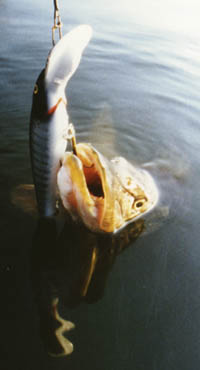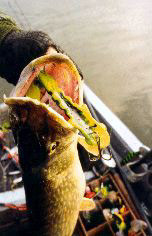 These
days there seems to be a whole lot more pike anglers who have realised the value
of having a system for their lure fishing. I don't meant that they go about their
fishing in a systematic manner, rather that they have a set of tackle that works
in a functional way to make their fishing go more smoothly. Look back ten years
or so and pike anglers would have just one rod and reel that got used for lure
fishing. There have always been lure users who took a different approach and maybe
had two or three lure outfits, but they were in the minority. At last year's PAC/Clic
charity lure day I was prepared for anything with four different lure rods set
up in the boat. I was not the only one to be similarly geared up by any means.
These
days there seems to be a whole lot more pike anglers who have realised the value
of having a system for their lure fishing. I don't meant that they go about their
fishing in a systematic manner, rather that they have a set of tackle that works
in a functional way to make their fishing go more smoothly. Look back ten years
or so and pike anglers would have just one rod and reel that got used for lure
fishing. There have always been lure users who took a different approach and maybe
had two or three lure outfits, but they were in the minority. At last year's PAC/Clic
charity lure day I was prepared for anything with four different lure rods set
up in the boat. I was not the only one to be similarly geared up by any means.It
makes a good deal of sense to have a set of lure rods that will deal with different
weight ranges of lures. To take an extreme example it would be difficult to cast
a half ounce jig on a jerkbait rod rated up to six ounces. Not impossible, but
far from easy. Given that most people tend to stick with lures in a fairly limited
weight range, probably something like three quarters of an ounce up to four ounces
(with odd lures that fall outside that range) for most pikers these days, between
two and four rods should see you well catered for.
Before
even thinking about rods you should consider reels. I say this because there are
many reasons why you should standardise on your reel choice. If you use different
reels on different rods, which might seem like a good idea if you are trying to
use the ultimate outfit for each method, you can run into handling problems. I
have found this in the past when I switched from using a rod fitted with a thumbar
operated reel to one rigged with a push-button spool release reel. It took a good
few casts to remember which reel I was using. This can lead to fumblings when
a fish is hooked, and more importantly when you want to give line or land the
fish. Particularly if you are like me and prefer to put the reel in free-spool
at these critical times.
When
you find a reel that suits you - and I have no recommendations to make other than
look for something robust, easy to service and with a good spares back up - stick
with it. Once you have two or three identical reels you will never be in the position
of being reel-less when one packs up on you out on the water. This is the major
reason for standardising on reels. If you have three rods all rigged with different
reels and one lets you down, what are your options? One way or another you will
be forced to compromise. If they are all the same you can swap reel bodies and
continue fishing with the outfit in question. If the spool release mechanism goes
down, switching side plates from one reel to another takes just a moment or two.
I have done this on a number of occasions in the days before I started carrying
around a few spares for my reels. This is another area where standardisation pays
off, one set of spares will always see you through.
 At
the bare minimum you need to carry a spare levelwind pawl or two. This is the
small part which fits in the underneath bit of the line guide on a multiplier,
and engages in the worm gear that traverses the line guide (apologies for the
technical jargon!). This part takes a lot of stick and when the wear reaches a
certain level the line guide will no longer travel back and forth, so your reel
will cease to lay line evenly and the bunching that this causes can lead to the
reel becoming unusable. A few pence invested in a handful of pawls can save a
lot of frustration and wasted time. Spares for the spool release mechanism are
also worth stocking up on too. Using reels that you can service 'in the field'
makes a lot more sense to me than having a super smooth, hi-tech machine that
an only be fixed by a fully equiped service department.
At
the bare minimum you need to carry a spare levelwind pawl or two. This is the
small part which fits in the underneath bit of the line guide on a multiplier,
and engages in the worm gear that traverses the line guide (apologies for the
technical jargon!). This part takes a lot of stick and when the wear reaches a
certain level the line guide will no longer travel back and forth, so your reel
will cease to lay line evenly and the bunching that this causes can lead to the
reel becoming unusable. A few pence invested in a handful of pawls can save a
lot of frustration and wasted time. Spares for the spool release mechanism are
also worth stocking up on too. Using reels that you can service 'in the field'
makes a lot more sense to me than having a super smooth, hi-tech machine that
an only be fixed by a fully equiped service department.
I
hope you can see the logic of having all your reels the same. There are a few
instances where exceptions can be made, say you require a specialised reel for
some application or other. Maybe a very slow retrieve ratio for jig fishing. In
this case you will have to break with the system. But don't fret, the system is
not set in stone, it has to be flexible.
Now
to the rods. A deal of standardisation helps here too. The main thing to consider
is handle style. Try and have consistent handle leng
ths
on your rods. That way your hands will automatically fall in the right place when
you change rods. This element of consistent 'feel' in a different outfits affects
both your performance and your confidence. Do not underestimate it. Not only can
handle length affect this element of feel, but so can handle shape and thickness.
I have altered quite a few lure rod handles for people over the years, and almost
always they want one from one manufacturer to match up with the rod that they
feel most comfortable using.
I
can only really discuss my own fishing when it comes to rod choices, but I am
sure you will be able to apply the following concept to your own situation. First
of all weigh up the lure types that you throw most frequently. For me this has
to be jerkbaits, big plastics, crankbaits and spinnerbaits. Most of these falling
in the one and a half to four ounce bracket. For the most part I can get by with
two rods for these lures; a short jerkbait rod of six feet or so, and a longer
one around six and a half feet for everything else. I can even throw jigs and
minnowbaits on the longer rod at a pinch. If pushed I could get away with using
either of these rods to fish any of my preferred lures, and do so when on short
bank fishing sessions. Should I feel the need I will take both rods with me.
The
reels on these two rods are both loaded with the same braid, in my case this is
100lb Power Pro. When I get out in a boat there is less need to cut down on the
gear carried, so at least three outfits will be taken along. (Unless it is proposed
to do a fair bit of bait fishing, in which case space in the boat would become
cramped with fourteen or sixteen rods between the two of us!) This will be either
another jerkbait rod, or another 'all rounder' - which is chosen will depend where
I am fishing and what lures I expect to be using. There is a good chance that
a second all rounder will have its accompanying reel loaded with finer braid,
say 65lb. This will give me better presentation with jigs and increased running
depth with everything else. On lure only days in the boat the full system would
comprise of four different outfits. The fourth being a dedicated jigging/light
lure set-up, the reel probably loaded with 65lb braid.
At
Llandegfedd I had the jig rod, two jerkbait rods (one heavy one lighter) and the
all-rounder. All four rods got used and I caught fish on two of them. One on the
all-rounder and one on the jig rod. It could be a mistake to neglect this latter
option on an obviously big-fish water. Although the pike I caught on the jig was
only twelve pounds or so it was my biggest of the day, on a day when no real lumps
showed up.
You might prefer
to go for a three rod system. Jig/light lure; crankbait/spinnerbait etc.; jerkbait.
Line strength, or I should really say diameter, varying between them as you choose.
The ability to fish similar lures on different line diameters can sometimes be
crucial, as I have already described in Pike and Predators, and is one of the
main reasons for carrying differently rigged up outfits. No point wasting time
swapping spools about when you could just pick up a different rod/reel combo.
When
you do use a system like this I heartily recommend that you don't leave lures
attached to the traces all the time. I have been in far too many tangles of one
sort or another when doing this. It might seem like a good idea in order to have
something different instantly at hand to throw back at a fish that has followed
a lure in. In my experience what is more likely to occur is that you will reach
for the landing net and find it is dragging a rod and reel behind it, the lure's
hooks stuck in the mesh. I have fished with one guy who puts his out of action
rod across the gunwales, letting the lure dangle from the rod end. This should
put it out of harms way, but apart from the rod causing an obstruction in the
boat, both the rod tip and the lure can now get caught up when you are casting.
You should always try and keep the gunwales clear for leading fish around the
boat in any case.
The idea
behind operating a system is to maximise your lure fishing time. While at the
same time maximising the presentational options open to you with the minimum of
tackle. Keeping it simple is the motto. Maybe carrying three or four rods doesn't
sound simple, but it is a lot better than carting six or seven around, which you
could end up doing if you were dead set on using the perfect outfit for each lure
type. Most of the hardcore lure guys I know take three rods each in their boats
when casting lures. So maybe I am already preaching to the converted.
Click
here for lure rod catalogue page.
(This
article first appeared in Pike and Predators issue 36)



